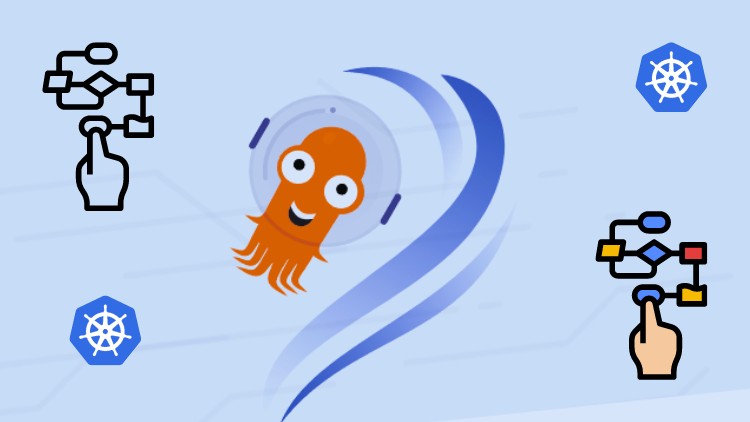
Argo Workflow Creation, CI/CD Integration, Cloud Integration, Optimization, Scalability and Real-World Deployment
What you will learn
Understand the core concepts of Argo Workflows, including its architecture, terminologies, and the advantages it offers for workflow automation and management.
Achieve proficiency in installing Argo Workflows, covering setup prerequisites, standard vs. quick-start installations, and installation verification.
Acquire foundational knowledge in Kubernetes essentials for deploying and managing Argo Workflows effectively within cloud environments.
Learn to adeptly create, manage, and debug Argo Workflow tasks, including Container, Script, Resource, and Suspend templates, with practical examples.
Implement and optimize advanced workflow patterns, mastering dynamic parameters, complex outputs, retries, priorities, and failure handling strategies.
Explore workflow optimization techniques, mastering the use of loops, timeout controls, backfill patterns, and other efficiency-enhancing practices.
Master the creation and management of Argo Workflow templates, including parameterized and cluster-wide workflows, and scheduling with Argo Cron.
Configure and leverage MinIO for artifacts storage, efficiently managing inputs and outputs across workflows, and integrating key artifacts.
English
language
Content
Note➛ Make sure your 𝐔𝐝𝐞𝐦𝐲 cart has only this course you're going to enroll it now, Remove all other courses from the 𝐔𝐝𝐞𝐦𝐲 cart before Enrolling!
Introduction
Argo Workflow – Introduction
Exploring Argo Workflow
Understanding the Benefits of Argo Workflow
Guide for Pre Requisites
Coding and Material Reference
Installation
Argo Workflow Quick Installation Guide
Argo Workflow Step-by-Step Installation Guide
Argo Workflow CLI Step-by-Step Installation Guide
Core Workflow Components
Hello World Workflow Management
Argo Workflow Detailed Architecture of Overview
Argo Workflow Controller Detailed Architecture of Overview
Argo Workflow Terminologies
Argo Workflow – CLI Demo
Installation Scope and Verification
Workflow Tasks Design
Argo Workflow Task Types
Argo Workflow Task – Container Template
Argo Workflow Task – Script Template
Argo Workflow Task – Resource Template
Argo Workflow Task – Resource Template – Delete Demo
Argo Workflow Task – Suspend Template
Argo Workflow When Clause Demo
Argo Workflow Task – Steps Template
Argo Workflow Task – DAG Demo
Argo Workflow Task – DAG Conditional
Workflow Data Flow
Workflow Parameters Global and Local
Workflow Dynamic Input Params
Workflow Output Param Simple and Complex
Workflow Templates
Workflow Templates Intro and Demo
Parameterized Argo Workflow Template
Parameterized List Argo Workflow Template
Argo Cluster Workflow Template
Argo Cluster Workflow Template – Advanced
Argo Workflow Cron
Workflow Control Features
Argo Workflow Input Params
Argo Workflow Input Params – Prev Step
Argo Workflow Key Only Artifacts
Workflow Artifacts
Argo Workflow Artifacts Storage – MinIO
MinIO Artifacts Demo
Installation – Advanced
Argo Workflow Cluster Install
Argo Workflow Install RBAC
Workflow Pattern
Argo Workflow Empty Dir Pattern
Argo Workflow Backfill Pattern
Argo Workflow of Workflow Pattern
Workflow Control Features
Argo Workflow Control withItems
Argo Workflow Recursion Control
Argo Workflow Timeout Control
Argo Workflow Retry Control
Argo Workflow Exit Handler Control
Argo Workflow Priority Control
Workflow Advanced Features
Argo Workflow Event Sources and Sensors
Argo Workflow Event Binding
Example Walkthrough
Example – Source
Example – Argument Artifacts
Example – Argument Configmap
Example – Colored Logs
Example – Docker Build Kit
Example – CI Output Artifacts
Example – CI Pipeline
Example – Cache Store and Restore
Example – Complex Conditions
Example – Enhanced Depends Condition
Example – DAG – Multiroot, Nested, Targets
Example – ConfigMap Sharing
Example – Workflow JSON Patch
Example – Workflow Loops Maps
Example – Workflow Params Args
Example – Workflow Task Parallelism
Example – Workflow DAG Parallelism
Example – Nested Workflow – Parallelism
Example – Aggregated Param
Example – Pod garbage collection
Example – Pod garbage collection with label
Example – Pod – Add Label and Metadata
Example – Resource Request Dynamically
Example – Dynamic ConfigMap Patch
Example – Retry Strategy
Example – Retry Different Strategies
Example – Using Secret
Environment Setup
Setup AWS EC2 Instance with AWS Linux
Setup AWS Windows EC2 Instance
AWS Resource Pricing Model
Minikube Setup in AWS EC2 Instance
CentOS VirtualBox Setup
VirtualBox GuestAddition
Minikube Setup in CentOS
Kubernetes Introduction – Beginners Refresher
Introduction to Containers
Docker Container Demo – Docker Hub
Kubernetes Architecture
Kubernetes Pods
Services in Kubernetes
Service Demo – Cluster IP
Service Demo – Node Port
Service Demo – Node Port – SSH Tunnel
Replicaset in Kubernetes
Deployments in Kubernetes
Kubernetes Additional Components
Argo CD Introduction
Core Features of ArgoCD
ArgoCD Architecture and Components
Installing ArgoCD on Minikube
Accessing the ArgoCD Web UI
Setting up a Sample Application – Web UI
Argo Rollout Introduction
Argo Rollout Why and Key Features
Architecture and Components
Argo Rollout Concepts
Argo Rollout Installation
Argo Rollout Simple Demo
Argo Rollout Dashboard